The New Jersey Devils revenge tour rolls on as the team takes on Auston Matthews, William Nylander, and the rest of the Toronto Maple Leafs in Thursday night’s home opener. Sheldon Keefe’s new team will look to avenge their current coach after a dominant two-game sweep over their former coach Lindy Ruff’s Buffalo Sabres. The new-look Devils quickly vindicated general manager Tom Fitzgerald’s belief that his team needed to get more snarl and be more challenging to play against without losing the quick strike pace that has made them so dangerous in the Nico Hischier/Jack Hughes era.
Related: 25 Metropolitan Division Predictions for 2024-25
Fitzgerald’s most perceptive move was taking his time with a coaching hire, and sticking to his plan of waiting until the first round of the playoffs concluded paid huge dividends, allowing him to swoop in and hire Keefe after the Maple Leafs were eliminated in Boston. Keefe was the best available coach when he was hired and probably the best possible coach for the Devils, regardless of timing. Like the team, he enters the season with a chip on his shoulder and something to prove. He has to be tired of hearing about the Leafs’ inability to make deep runs in the playoffs without the perspective of the profoundly flawed roster he was asked to win with. In less than six months with the Devils, his impact is noticeable. He has brought an energetic spirit to the team that better matches their current needs and a high-tempo play style tailor-made for the roster.
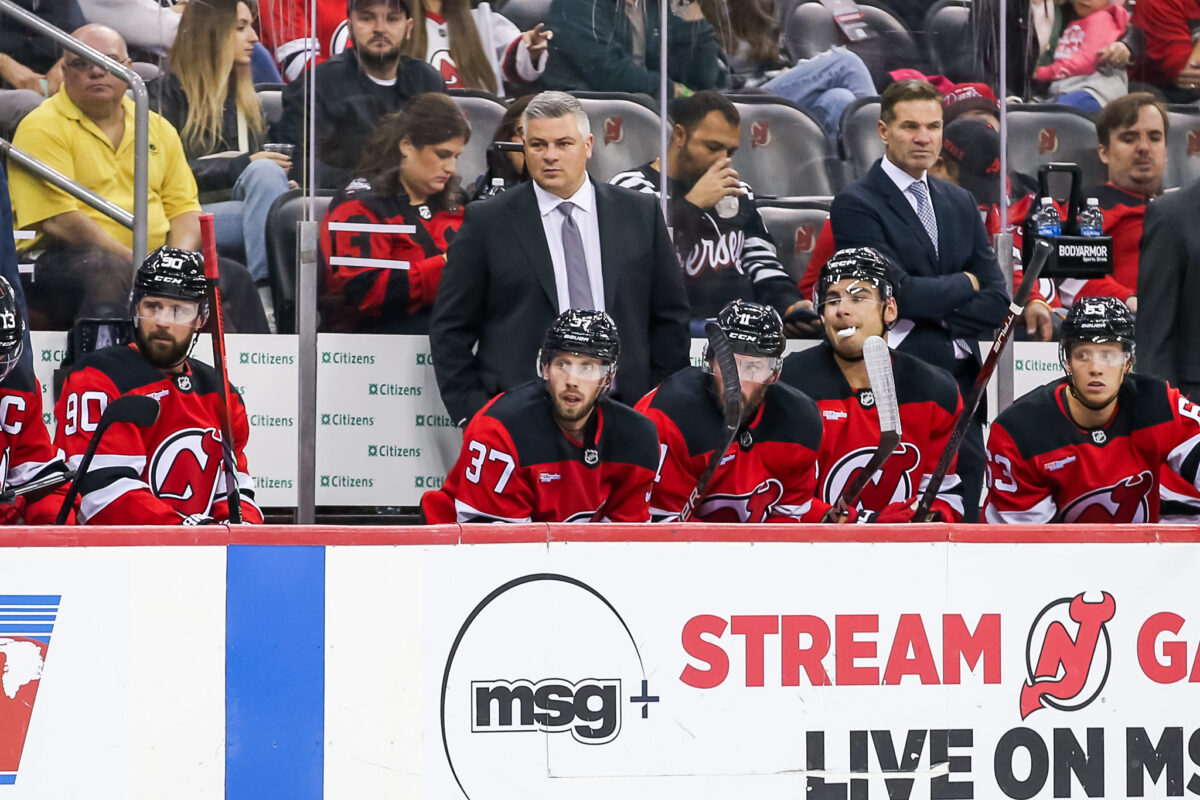
In Prague, the team showed it could follow multiple paths to victory. Coming off a season where it seemed they could only be successful if everything went right, this is tremendous progress. The Devils seized the lead in game one and cruised to victory. In the second game, they gave up a controversial goal to go down 1-0 in the second period and stuck to their game. Far too often last season, they could not staunch the bleeding, and once a goal was scored, the floodgates opened. They also consistently had difficulty overcoming deficits because teams would trap and take away the middle of the ice, forcing them into a style they were neither built for nor willing to play.
This year’s edition quickly demonstrated that it was indeed a new season. Three minutes after going down a goal, rookie defenseman Seamus Casey took the puck in the high slot, toe-dragged around a defender, and roofed a blast past a locked-in Devon Levi for his first NHL goal. The Devils never looked back, dominating the third period, finding two goals set up by great individual plays from Hughes and Jesper Bratt, and sweeping the Global Series. It was a weekend most Devils fans won’t soon forget. The challenge now is to ensure that this unique event isn’t the team’s high point, unlike last season’s Stadium Series. Here are four keys for the Devils to ensure that does not happen.
Continue Applying Relentless Pressure
When asked to describe the style of play he planned to bring to New Jersey, Keefe said he wanted to play aggressive, high-pressure hockey in all three zones. It is only two games into the season, but Fitzgerald and the players have fully bought into Keefe’s plan. After hiring Keefe, Fitzgerald spent his summer building a stronger team that played with bite but was unwilling to sacrifice its speed and skill for those attributes.
The play of new acquisitions epitomized the Devils’ newfound ethos of relentless pressure all over the ice: Paul Cotter, Jonathan Kovacevic, Stefan Noesen, and Brenden Dillon. The four had significant contributions in the two games, with three netting goals in the series. Kovacevic, an afterthought most considered as organizational depth added in a trade with the Montreal Canadiens for a draft pick, has rocketed up the roster since training camp began and has formed a pairing with Jonas Siegenthaler that logged the most shifts of any pair over the first two games.
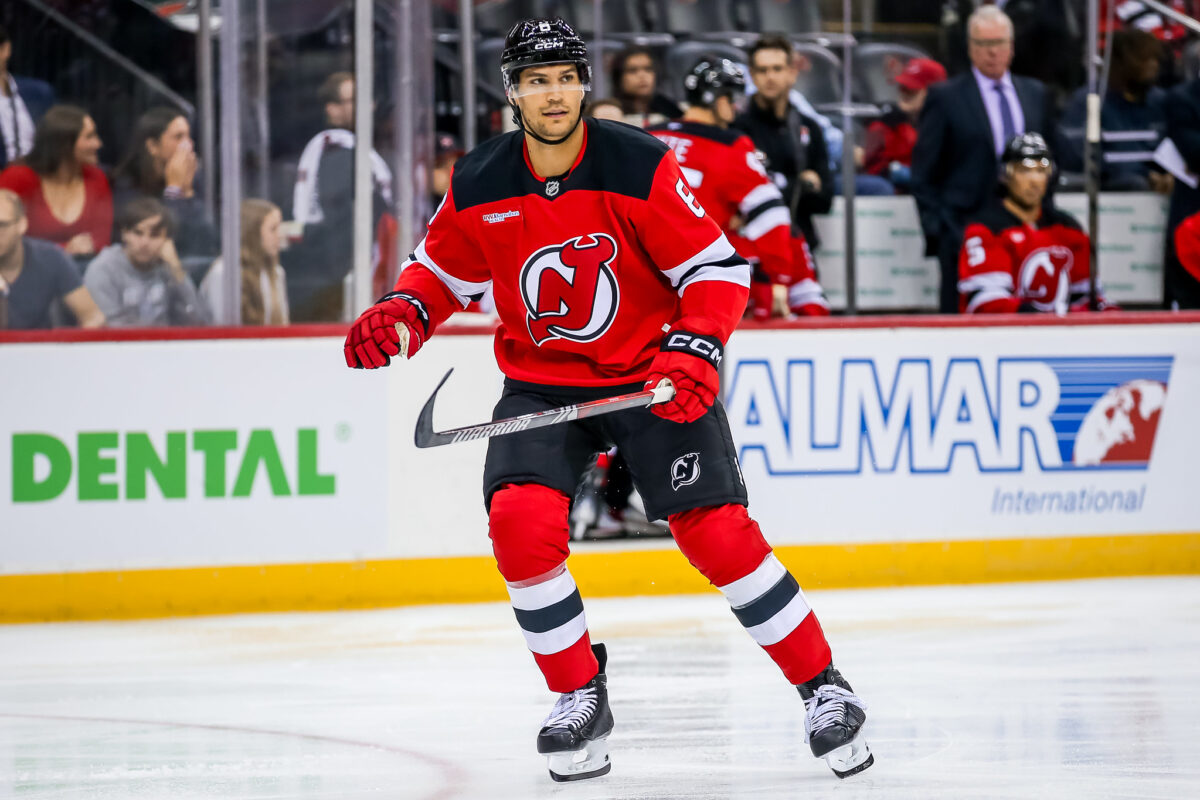
Relentless pressure has been Curtis Lazar’s calling card since Fitzgerald acquired him at the 2022 Trade Deadline. “How I play is never going to change within a system because it’s kind of framework stuff.” Lazar shared after practice on Tuesday. Far too often in the past, it felt like he was playing at a different speed and style than his teammates. Now it appears the entire team has bought in, and the commitment to constant attack has already led to tangible results, with almost all of the team’s seven goals coming due to pressure either on the forecheck or in the D zone leading to a clean breakout and transition. The players have noticed it as well.
“A lot of times its how we forecheck. (We) gotta kind of pull the reins in a little bit. You don’t want to be too over-anxious and over-commit. But it’s funny, you play those two games, they’re so high energy, and you go back and watch your shifts, and see how connected we all are, not even as a line but the whole team in their D zone. How it’s resulting in breaking the puck out, its stifling teams in the neutral zone too. It’s allowing us to kind of get that mojo we’re looking for.”
Curtis Lazar, October 8, 2024
This is a point of emphasis the team will need to continue nurturing throughout the season to ensure they can generate scoring opportunities via pressure rather than just on the rush when the games get more difficult. Lazar is already seeing how the new style and the intentionality of the style are working, “it’s a small body of work we’re dealing with, but that (success) stems from the forecheck. We talked about giving them no free passes. Keep an eye out there if you’re at the end of a shift. You know, put on pressure. And when they’re at the end of their shift, and they dump it in, it’s a free puck, so then you get a chance to go at them.” The ability to break out quickly and cleanly and the return of stretch passes and the immediate transition have breathed new life into the team and bodes well moving forward.
Box Outs Lead to Limiting High-Danger Opportunities
After last season, Fitzgerald said his team needed to get stronger. What is now clear is that he was not only speaking to players on the roster, but he was talking to his pro and amateur scouting departments as well as himself. Keefe has also bought into this mindset of more decisive play and sought to implement a more muscular, tougher style of play from the outset of training camp. It was clear to anyone in attendance that this would be a fast-paced, physical camp emphasizing using force to create turnovers and strength to clear the crease. Far too often last season, the Devils allowed players to get inside position on defenders around the goal, leading directly to empty net tap-ins and conversions of high-danger chances. The team was fifth in the NHL for high-danger goals allowed last season.
Devils players referred to “box-outs” as a focus of training camp. Kovacevic indicated that it is “something we’re talking about, something we worked on today. We’re going to continue to work on and highlight on video both good and bad boxouts. That’s gonna be a big area of emphasis. It’s one of our biggest things, it’s a high danger chance if they can get a rebound or a tip. Inevitably, they’ll get some, but it’s one thing that I think is just like a mindset thing, and if you can be really focused on it, you can eliminate a lot of chances around you.” They also got the best available high-danger shot-stopper in Jacob Markstrom. These efforts were displayed in Prague and traced back to the hiring of Keefe and Fitzgerald’s additions. Lazar thinks it has made an immediate impact, “I’ve been talking to a few guys in Buffalo, and they said just how hard it is for them to get to our net. They’re playing with that, and that’s something you want to keep on doing.” Continuing this effort will be a key to the Devils’ success.
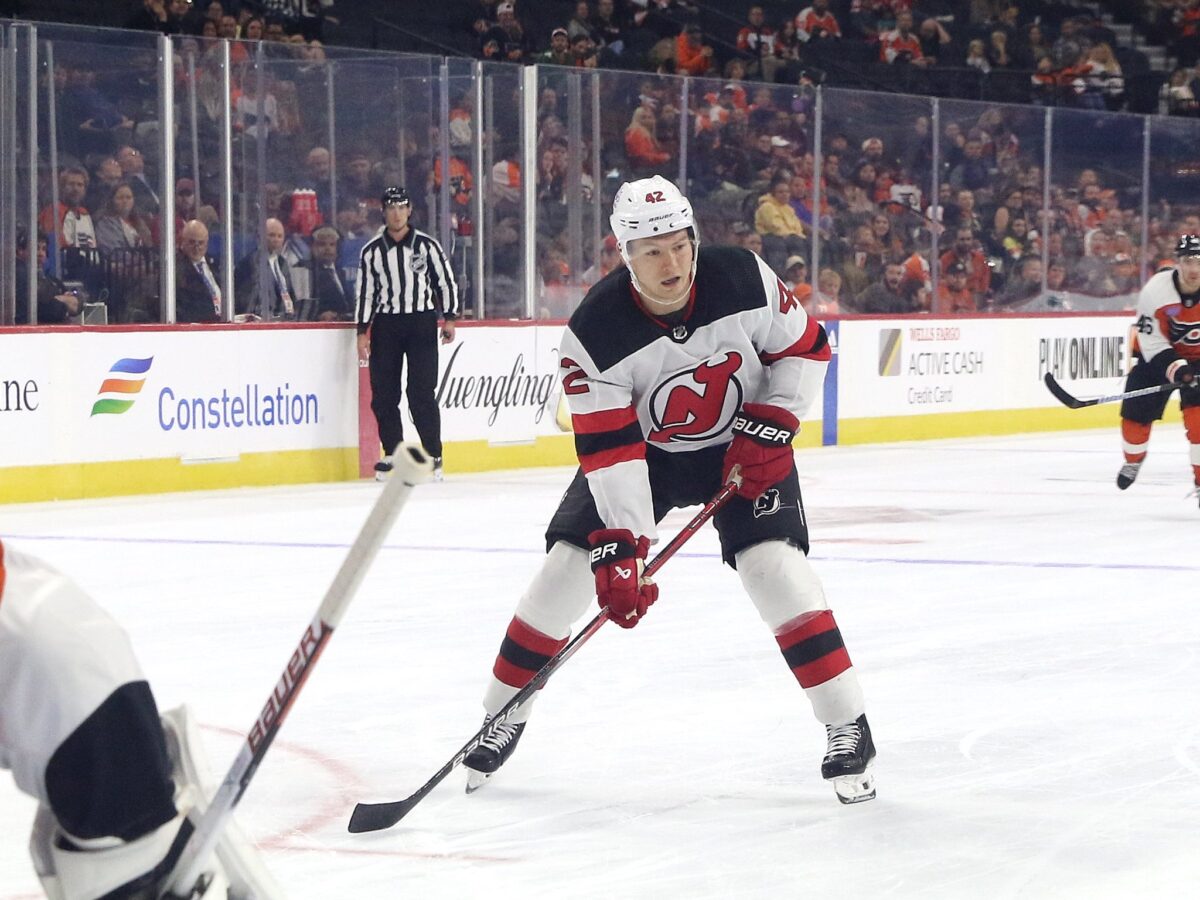
Dillon, who spent last season clearing the crease and shot paths in front of Vezina Trophy winner Connor Hellebuyck, knows firsthand how important providing clear lines of sight is to a goalie’s success. His play and off-ice leadership have immediately earned him admiration from his teammates and the coaching staff, who bestowed upon him the “A” in his second game as a Devil. “Anytime you know your teammates and coaching staff, give you that honor. It means a lot to me. I think for our group, I’m just so, so happy to be a Devil and just proud to be a Devil. And I think having an “A” on my jersey too, and the guys that have done that before, and just knowing what that means, I may not be the biggest rah-rah guy, but, you know, I like to lead by example and just make sure that, you know, the guys are going as best we can.” Dillon’s leadership was evident throughout the game, as he did not back down from challenges and defended his teammates.
Dillon showed many ways to help your goaltender, including blocking shots. “If the goalie can see the shot, they’re gonna save it. (Clearing the front of the net is) one of my strengths. (It is a point of emphasis for) all of our group, we’ve got a mixed bag, the offensive guys, defensive guys, but Keefer, from day one, has made that a point of emphasis that we want to be making sure we’re doing our best (to box opponents out). It’s tough when you got 6-foot-7 Tage Thompson and some of these guys coming around, but if you can, even if it’s an extra second or tie-up of the stick, you know, can only benefit (the goalie and team).” Few things are more demoralizing to a team than fighting through a possession and ending up with the puck in the back of your net because a defenseman got outmuscled to a free puck or failed to put themselves between their man and the goal. Players like Dillon and Kovacevic were brought in to ensure the trend ended last April.
Disciplined Physicality
Signing and trading for players who add physicality and snarl is essential, but it doesn’t mean anything if the aggression can’t be disciplined. The Devils showed in Prague that they were unafraid to engage with physicality. Deploying that physicality purposefully and with control was a major part of their success in Prague. Over the course of the two games, the team was credited with almost 40 hits. The team leader was Siegenthaler, second was diminutive forward Jesper Bratt, showing that the roster has fully bought into the plan. By contrast, last season, Bratt finished with approximately .75 hits per game; this season, he is averaging two per game. While a small sample size, it does show that the plan drawn up by Keefe, namely forechecking and attacking in all three zones by all five players, is already being implemented.
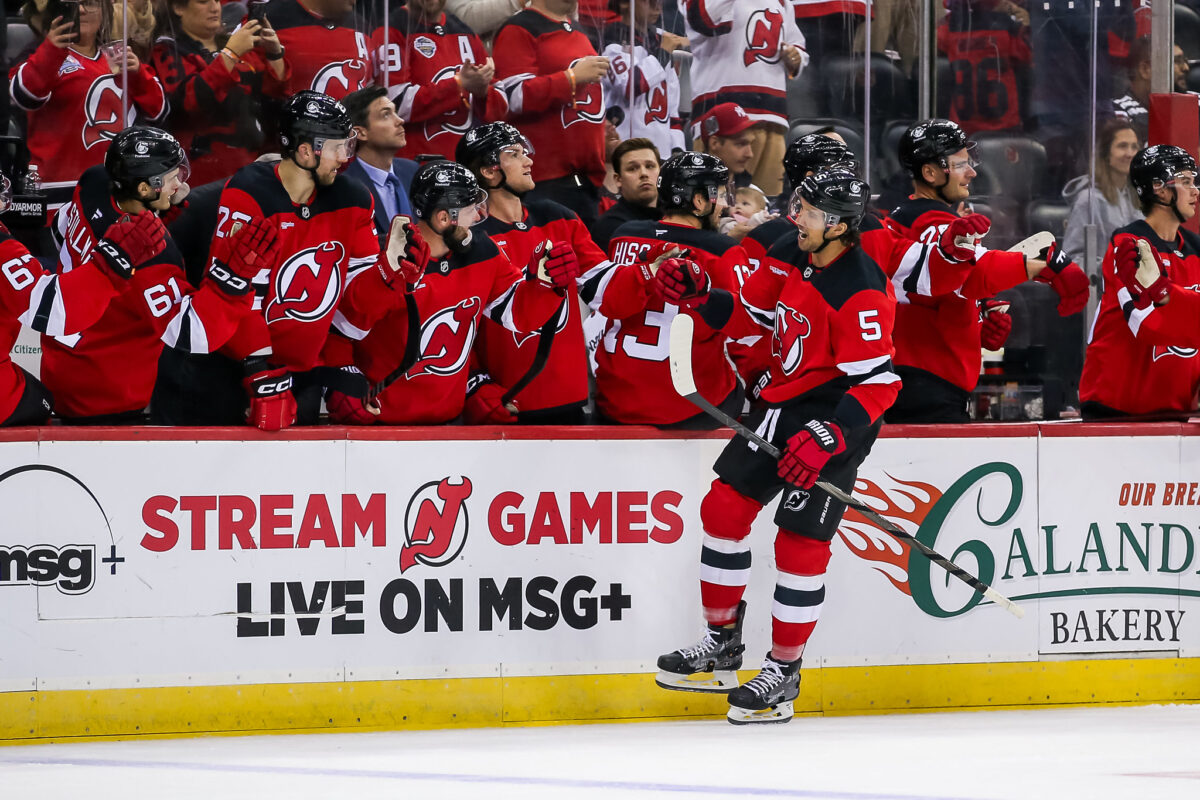
Another noticeable aspect of the team’s physicality is that while the hits and blocks are happening more frequently, they maintain their structural and behavioral discipline. In the first game, they took four penalties, none resulting from being overly aggressive. In the second game, the only Devil to be penalized was Dillon, whose check on J.J. Peterka cost him two minutes for interference and another five defending himself against Alex Tuch, who objected to the hit. The hit by Dillon was a borderline interference infraction that, absent Peterka’s injury, was unlikely to be called. It stemmed from him stepping up at the blue line and attempting to kill a play before it became dangerous in the d zone.
The games in Prague were doubtlessly emotional. The Devils were playing against their former coach, who did not see eye to eye with several current players. Buffalo was playing to establish themselves as a playoff team and fight for their new coach against the team that fired him. You also had several players looking to make good impressions on their new teammates and coaches and others trying to take advantage of the opportunity to stay in the lineup. For New Jersey, they had been working on playing with aggression since practice began. The ability to physically impact the game while remaining within the team structure and concepts will make a huge difference for New Jersey moving forward.
The team has also responded to each other in a way that seemed missing last season when opponents, including the Sabres Connor Clifton, could take liberties with New Jersey’s star players without the threat of retribution or even having to pay a significant cost. That has changed, according to Lazar, “you see then Dilly (Dillon) steps up, and does a hit like that, and they turn (the puck) over, and you got guys that, you know, we all have each other’s back. No one’s afraid to mix it up. And I think that’s fun, too. So it’s almost like we’re asking for that opportunity to all have each other’s back…So again, we’ll stay true to who we are, but if things go one way, we’ll be there to answer it.” It is way too early to tell, but the cohesion in the room seems evident, and Keefe has the team playing for each other, not for themselves, and the collective agreement to stand up for each other is the biggest indicator of that change.
Attacking the Net Directly
As Lazar indicated, the games will only get tougher, and there will be less space to maneuver as the season unfolds and teams get more physical. Last season, the Devils’ answer to this was to try to outskate their opponents and look to score primarily on the rush. When teams inevitably took the lead on New Jersey, as happened 70% of the time to begin games last season, opponents quickly learned that by clogging the neutral zone and forcing New Jersey to the perimeter, the Devils would struggle to find a plan B. Under Keefe, that has changed. The Devils now put a premium on being able to score and, therefore, win in multiple ways. They want to generate chances off their forecheck through pressure in the neutral zone that causes turnovers and quick strikes in transition, from structured breakouts with pace to using their speed and creativity off the rush.
Timo Meier struggled often in Ruff’s system despite leading the team in goals since his acquisition. Whether it was the style of play, where he was deployed in the lineup or his health, it just didn’t seem to fit. With the new emphasis on finding goals through physicality and capitalizing on turnovers and dirty goals in greasy areas, Meier could end up as one of the main benefactors of the change. “We’ve worked on some stuff and kind of practice some different ways to get (to the front of the net), and, yeah, for me, it’s a big part of my game to get inside. And that’s where you got to be successful scoring goals every year, every game you want to ensure you get inside there. And that’s where the game is won.” His first goal of the season resulted from him going directly to the crease and fending off Sabres to corral a loose puck and fire it into the empty cage.
Even Meier knows that to create multiple offensive opportunities and ways to score, relying on the rush as the only driver of scoring is impractical. Now, “we try to find different ways and how to create offense. But yeah, it all starts in the D zone, too; if you defend well, you’re going to get the puck more, you’re going to play more with the puck, so I think that’s it’s a puzzle of many pieces that you got to do the right thing every time to create that offense.” Meier stands to be one of the biggest beneficiaries of the emphasis on driving directly to the net and not settling for perimeter shots.
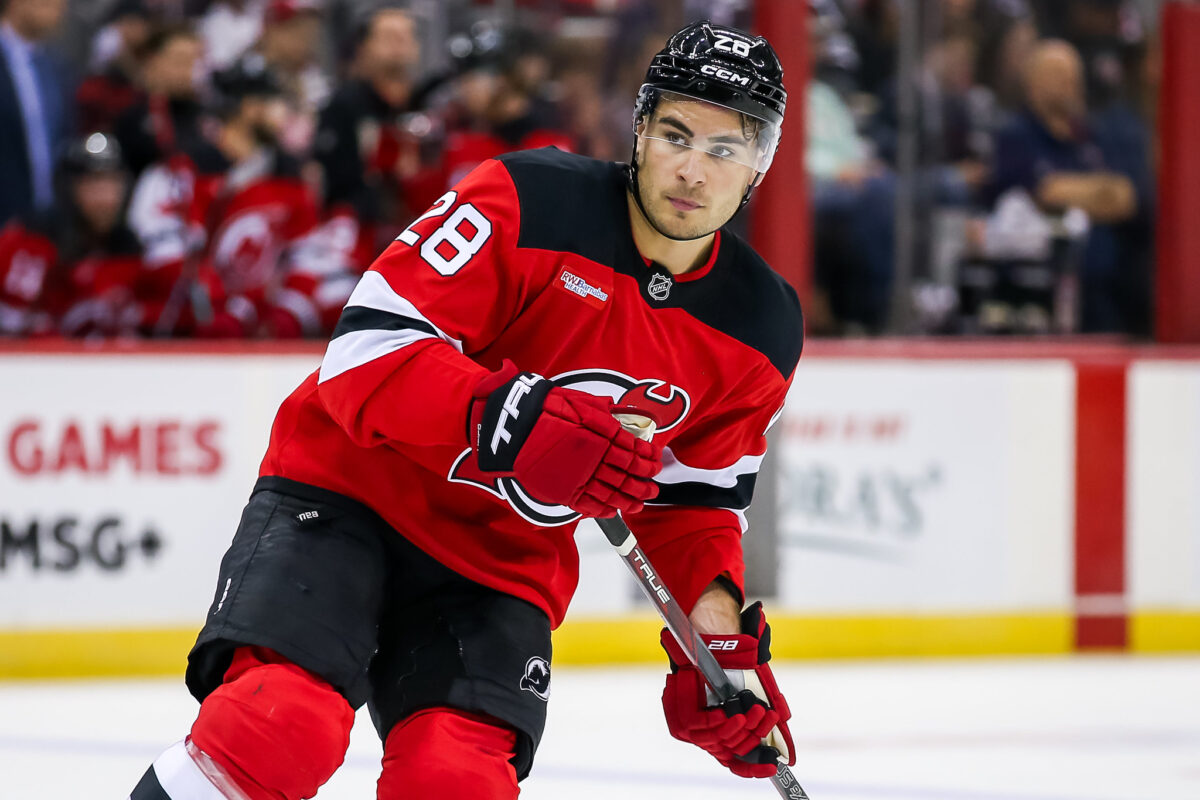
The goal by Paul Cotter, set up by Hughes’ attack and hold-up play, who entered the zone, drew two defenders to him on the boards, clearing space where an oncoming Cotter filled the high slot and buried the pass from Hughes after deking goaltender Levi. Similarly, Meier’s goal was set up by Bratt attacking the net, attempting to go around the goalie and look to score on a wrap-around. The puck dislodged from his stick as he came around the post but slid to Meier, who deposited it into the net, which was vacated by the goalie chasing Bratt. Last season Bratt and Hughes likely settle for earlier shots from the perimeter that would be viable but have much less of a percentage of leading to a goal.
The Devils announced to the NHL that this is not the same easy-to-defend and play-against team from last season. The feeling around the team is similar to the confidence felt by the players at the start of the 2022-23 season like they know something the fan base does not. With the emphasis on intelligent physicality, clearing opponents out of the crease, and taking pucks directly to the net, the team can be there when the games matter most.
